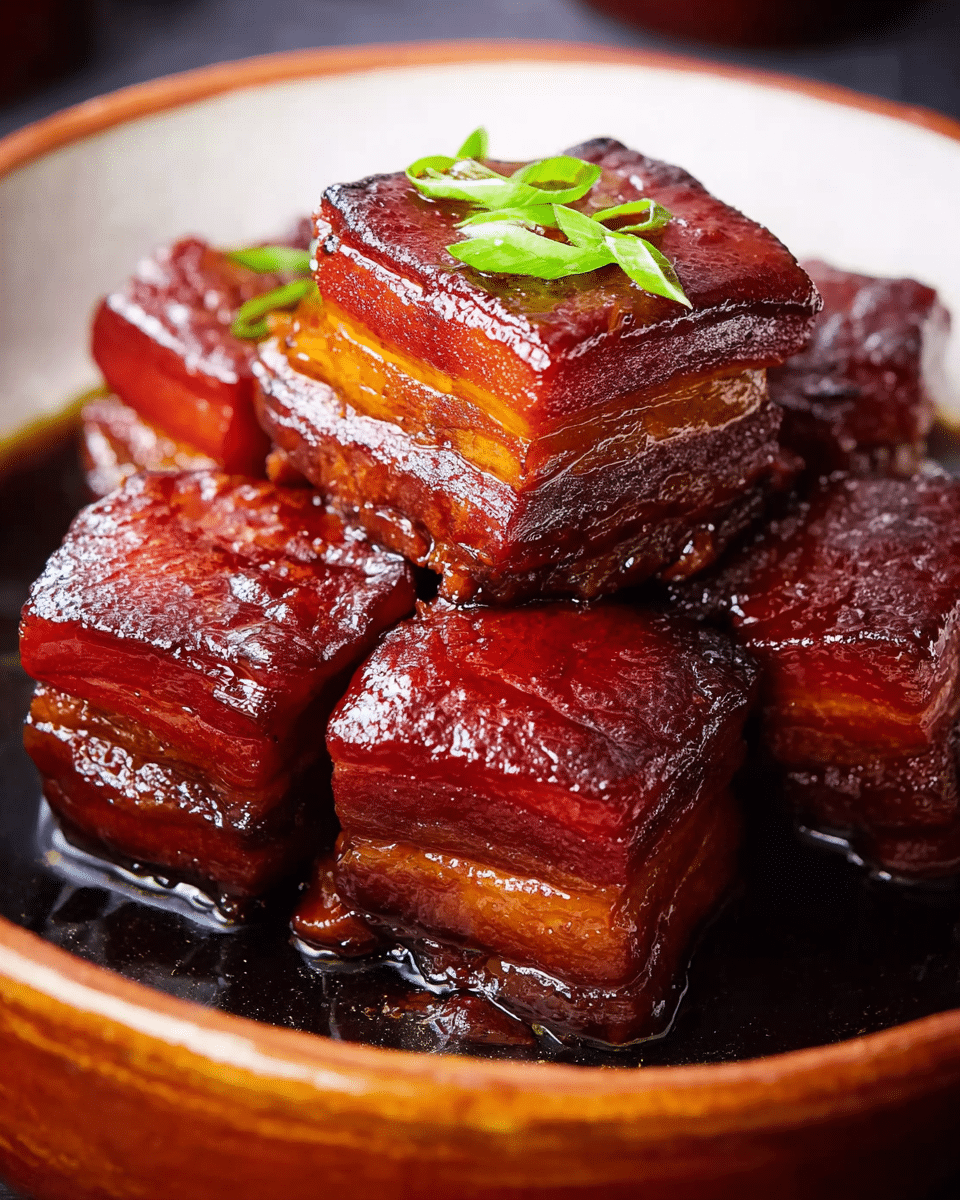Dong Po Rou is a delicious and tender braised pork belly dish, famous in Chinese cuisine for its melt-in-the-mouth texture and savory, sweet sauce. The pork belly is slowly braised in a rich combination of Shaoxing wine, soy sauces, and rock sugar, creating a flavorful glaze that complements the richness of the meat. This recipe is perfect for a special family meal or when you want to impress guests with a traditional and flavorful dish.
Full Recipe:
Ingredients
-
600 g pork belly
-
2 bunches spring onions/scallions, cut into 2-inch pieces
-
6 slices old ginger
-
¼ cup Shaoxing wine
-
3-4 tbsp light soy sauce (to taste)
-
2 tbsp dark soy sauce
-
50 g rock sugar, chopped (to taste)
-
1 cup hot water (or enough to cover all sides of the pork belly)
-
Sliced spring onions (for garnish)
Directions
-
Prepare the Pork Belly
Wash and clean the pork belly, then blanch it in boiling hot water for 1 minute. Drain and cut the pork belly into 2×2 inch squares. -
Layer Ingredients in Pot
Line a tall stockpot or saucepan with spring onions, then place the ginger slices on top. Arrange the pork belly skin-side down on the ginger. -
Add Liquids and Sugar
Pour the Shaoxing wine, light soy sauce, dark soy sauce, and rock sugar over the pork. Add enough hot water to cover all sides of the pork belly. -
Braise the Pork
Cover the pot and bring the mixture to a boil over medium-high heat. Once boiling, lower the heat to low and simmer for 90 minutes. -
Flip and Continue Cooking
After 90 minutes, carefully flip the pork belly over and simmer for another 90 minutes, occasionally basting the skin. If the liquid evaporates too quickly, add more water. -
Finishing Touches
After braising, adjust the seasoning by adding more sugar or soy sauce if desired. Remove the grease from the sauce by sieving it before serving over the pork belly. -
Serve
Garnish with sliced spring onions and serve hot with rice.
Nutrients
The nutritional values will vary depending on portion sizes, but here’s an estimate for one serving of Dong Po Rou (based on 4 servings):
-
Calories: 500–600 kcal
-
Protein: 30–35 g
-
Carbohydrates: 15–20 g
-
Fiber: 1–2 g
-
Sugars: 6–8 g
-
-
Fat: 35–40 g
-
Saturated Fat: 12–15 g
-
-
Cholesterol: 70–90 mg
-
Sodium: 800–1000 mg
-
Calcium: 20–30 mg
-
Iron: 3–4 mg
This estimate is for the pork belly without additional sides. The nutrient values may vary depending on the specific ingredients and cooking methods.
The Key Ingredients of Dong Po Rou
The magic of Dong Po Rou lies in the harmonious balance of its ingredients, each playing a crucial role in developing the dish’s unique flavors. The primary ingredient is the pork belly, which provides a rich, fatty texture that is key to the dish’s melt-in-your-mouth appeal. When slow-braised, the pork belly becomes so tender that it almost dissolves in your mouth, with the fat rendering down and blending beautifully with the braising liquids.
The braising liquid itself is a combination of Shaoxing wine, light and dark soy sauces, and rock sugar. Shaoxing wine, a traditional Chinese rice wine, brings an aromatic and slightly sweet flavor that forms the base of the dish’s depth. The light soy sauce imparts a savory, umami-rich flavor, while the dark soy sauce gives the dish its characteristic color and additional complexity. The rock sugar adds a subtle sweetness that balances the savory and salty elements, giving the dish its signature glaze.
Ginger and spring onions also play essential supporting roles, with ginger adding warmth and aromatic complexity, while spring onions contribute freshness and a subtle sharpness to counterbalance the richness of the pork.
The Art of Braising Pork Belly
Braising is the key cooking method for Dong Po Rou, and it’s what allows the pork belly to become so tender and flavorful. The process begins by blanching the pork belly in boiling water, which removes any impurities and helps to clean the meat before braising. After this, the pork belly is cut into small squares, making it easier to cook evenly and ensuring each piece absorbs the full flavor of the braising liquid.
The pork belly is then placed in a stockpot with ginger and spring onions. The braising liquids—Shaoxing wine, soy sauces, and rock sugar—are poured over the pork, and hot water is added to cover the meat completely. The pot is then brought to a boil and simmered for 90 minutes. During this time, the flavors meld together, and the pork belly begins to absorb the rich sauce.
After the first 90 minutes, the pork belly is flipped over and braised for another 90 minutes. This ensures that both sides of the meat are evenly cooked, and the sauce has a chance to penetrate every layer of the pork. As the braise continues, the pork becomes tender and the sauce thickens, forming a luscious, sticky glaze that clings to the meat.
Flavor Profile: Sweet, Savory, and Rich
The unique combination of sweet and savory in Dong Po Rou is what makes it so irresistible. The pork belly’s richness is balanced by the slight sweetness of the rock sugar, which enhances the savory depth of the soy sauces and Shaoxing wine. The ginger adds warmth and an aromatic kick, while the spring onions give a refreshing bite that cuts through the richness of the dish.
The result is a glossy, caramelized glaze that coats each piece of pork belly, giving it a beautiful shine and an intoxicating aroma. The flavors are deep and layered, with each bite offering a satisfying balance of umami, sweetness, and richness. When paired with steamed rice, the sauce is perfect for drizzling over the rice, creating a mouthwatering combination.
Adjusting the Flavor to Your Preference
While the recipe offers a balanced flavor profile, Dong Po Rou is versatile, and you can adjust the seasoning to suit your taste. If you prefer a sweeter dish, you can increase the amount of rock sugar, allowing the sauce to become more caramelized and rich. Alternatively, if you prefer a saltier, more savory version, you can adjust the amount of light soy sauce.
You can also experiment with the addition of other aromatics or spices, such as star anise, cinnamon sticks, or a dash of five-spice powder. These ingredients can add a deeper, more complex flavor, though the traditional recipe keeps it simple with ginger and spring onions to allow the flavors of the pork and braising liquid to shine.
Serving Dong Po Rou
Dong Po Rou is traditionally served with steamed rice, which helps balance the richness of the pork belly and soak up the flavorful braising liquid. The dish can be garnished with freshly sliced spring onions for a burst of color and a bit of fresh sharpness. For a complete meal, consider pairing it with a side of stir-fried vegetables or a light soup.
This dish is perfect for special occasions, as it’s both impressive and comforting. Its tender, melt-in-your-mouth pork is a showstopper, and the deep, savory glaze is sure to win over anyone who tries it. Whether for a Chinese New Year celebration, a family gathering, or a dinner party, Dong Po Rou is a dish that will leave a lasting impression.
Health Considerations
While Dong Po Rou is a rich and indulgent dish, it can still be enjoyed as part of a balanced meal. The pork belly provides a good source of protein and iron, though it is high in fat, particularly saturated fat. For those looking to lighten the dish, consider using a leaner cut of pork, though the traditional recipe relies on the fat content of the belly to provide the tender, melt-in-your-mouth texture that defines the dish.
If you want to reduce the fat content of the dish, you can skim off some of the grease from the braising liquid before serving. Additionally, pairing Dong Po Rou with steamed vegetables or a light salad can help balance out the richness of the pork.
Conclusion
Dong Po Rou is a classic Chinese braised pork belly dish that combines savory, sweet, and rich flavors into a melt-in-your-mouth experience. With tender pork belly slowly braised in a fragrant combination of Shaoxing wine, soy sauces, and rock sugar, this dish is perfect for special occasions or when you want to impress your guests with a traditional and flavorful meal. Whether served on its own or with a side of rice, Dong Po Rou offers a delicious and comforting way to experience the heart of Chinese cuisine.






